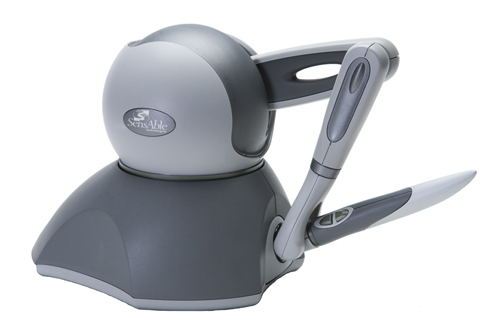
PHANTOM haptic device used to create virtual clay models. Courtesy of Sensable.
July 26, 2012
Every shiny, new 3D printer needs objects to print. Some of these objects are created using 3D scanners, but most are built using CAD programs. Your standard CAD program has plenty of menus and options to help with the design process, but don’t provide much in the way of physical feedback until a prototype comes hot off the printer.
Ping Fu, Geomagic CEO, told Rapid Ready at RAPID 2012 that the future of design is creating a sense of “digital reality.” This conviction is what led Geomagic to acquire Sensable in April of this year. The first fruits of the acquisition have come in the form of updates to Freeform and Claytools, which incorporate elements of Geomagic’s technology into Sensable’s modeling software.
Freeform v12 SP2 updates the software released earlier in the year. New features include support for 3D Connexion’s SpacePilot Pro and SpaceMouse Pro, and, according to the company, improved auto-surfacing capabilities. Autosurfacing allows Freeform’s voxel or polygonal models to be converted and imported into more traditional CAD programs, such as Dassault’s SolidWorks and PTC’s Creo, as well as CAM products for tool path generation.
“I am impressed with the way that Geomagic’s surfacing capabilities are now incorporated into Freeform Plus,” said Nancy Hairston, principal of SculptCAD in Dallas. “It’s fast and produces excellent results, especially on thin objects and highly detailed areas which can be difficult to handle.”
Claytools v4 is a brand new version of the software aimed at sculptors, prototypers, model makers, jewelry designers and digital content creators. The new version offers a number of new features including curve spheres, new mesh tools, the ability to paint models, new carving tools and a hot wax tool.
Both Claytools and Freeform use a haptic device that provides force feedback allowing designers to use their sense of touch to create 3D models. The software provides a virtual piece of clay that can then be molded using the haptic device. This approach might not be vital for every CAD design, but are generally intended for applications that require a more organic feel.
Products like Freeform and Claytools make it faster and easier to design great products digitally – freed from the constraints of conventional CAD – and produce them using new additive fabrication methods, or just as easily import them into traditional CAD/CAM formats when needed. – Joan Lockhart, vice president of sales and marketing, Geomagic Sensable Group
Below you’ll find a video that demonstrates Claytools.
Source: Geomagic
Subscribe to our FREE magazine, FREE email newsletters or both!
About the Author
John NewmanJohn Newman is a Digital Engineering contributor who focuses on 3D printing. Contact him via [email protected] and read his posts on Rapid Ready Technology.
Follow DE






